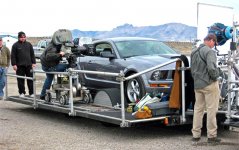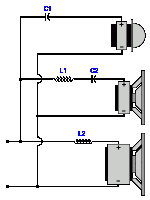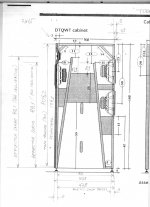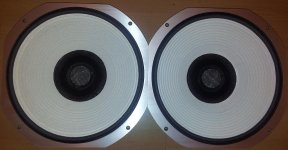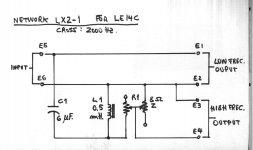Well my amp is realy 300W x 2-Ch @ 2-Ohms.
Be sure your power supply can deliver enough current to keep the amp happy at whatever impedance you end up using.
well as the tweeter is the most efficient it's likely to require a pad which would be determined by eff/sensitivity of the mid impedance choice,no?
i should butt out and let the OP ask what he needs to know but given his apparent confusion of crossovers and impedance would it be incorrect to ask him if he understands the concept of impedance over frequency?
i should butt out and let the OP ask what he needs to know but given his apparent confusion of crossovers and impedance would it be incorrect to ask him if he understands the concept of impedance over frequency?
Last edited:
I used to be quite good on amplifiers, but am rusty now... but I'll have a go. Sorry it's not a quick answer.
Crunch GP2150 2 Channel Ground Power Amplifier:
Crunch GP2150 2 Channel Ground Power Amplifier [Crunch GP2150] - PS79.99 : Car Audio 4 Less, Car Audio System
This is a car amplifier, so runs on single rail 12V car battery power.
Problem with car stereo is the lack of volts available, so you tend to use 4 ohm drivers which are louder. You can also use bridged mode for more power with two amplifiers in opposite polarity, but that would get complicated. With bridged mode, each amp is seeing nearer 2 ohms with a 4 ohm driver.
I don't think we'll be looking at bridged mode here. Looks like the amplifier has built in filters of some sort, so a 4 ohm subwoofer and 4 ohm fullranger above 250Hz is doable with little effort.
You'll need two amps for stereo by the look of it going that route. Or build a 4 ohm speaker with a crossover.
I'd never use a car system domestically. You need a 12V power supply. Given the cheapness of domestic amps which run on mains voltage for a +/- 30V power rail and hifi 4-8 ohm speakers in second-hand shops, that is what I would get.
Electrics are dangerous if you don't know what you are doing.
Crunch GP2150 2 Channel Ground Power Amplifier:
Crunch GP2150 2 Channel Ground Power Amplifier [Crunch GP2150] - PS79.99 : Car Audio 4 Less, Car Audio System
This is a car amplifier, so runs on single rail 12V car battery power.
Problem with car stereo is the lack of volts available, so you tend to use 4 ohm drivers which are louder. You can also use bridged mode for more power with two amplifiers in opposite polarity, but that would get complicated. With bridged mode, each amp is seeing nearer 2 ohms with a 4 ohm driver.
I don't think we'll be looking at bridged mode here. Looks like the amplifier has built in filters of some sort, so a 4 ohm subwoofer and 4 ohm fullranger above 250Hz is doable with little effort.
You'll need two amps for stereo by the look of it going that route. Or build a 4 ohm speaker with a crossover.
I'd never use a car system domestically. You need a 12V power supply. Given the cheapness of domestic amps which run on mains voltage for a +/- 30V power rail and hifi 4-8 ohm speakers in second-hand shops, that is what I would get.
Electrics are dangerous if you don't know what you are doing.
Last edited:
Well, I could buy a car "of the future", since it is a fact that they will go from 12 V to 48 volts ...
Of course, costs are not justified to remove the amplifier and then give it the use that the OP requires ......
Oh, the drinks from last night have hurt me, leave it there, I haven't said anything!
Por que los sistemas electricos de los coches estan cambiando de 12 a 48 voltios - Tecvolucion
Of course, costs are not justified to remove the amplifier and then give it the use that the OP requires ......
Oh, the drinks from last night have hurt me, leave it there, I haven't said anything!
Por que los sistemas electricos de los coches estan cambiando de 12 a 48 voltios - Tecvolucion
I would like to make a 3-way speaker with all 3 drivers being 8 ohm individual.
If i connect all 3 drivers to 3-way crossover designed for 8 ohm drivers will it require 8 ohm amp output or 2 ohm amp is just fine?
So we are talking 3 speakers and a 3 way crossover, period.
That is fine and will work properly.
Such a system will present 8 or 4 ohm load to your amplifier, depending on using 8 or 4 ohm speakers.
So far so good.
BUT then you write:
No.Do you think if there is a way to make it to 2 ohms
Good.I have ability to use 4 ohms drivers and XO so it would result in 4 ohms requirement from amp
What?Wouldnt it be better than 8 and 2 ohms scenario mentioned above?
NO NO NOIf i would connect 2 x 8 ohms crossovers in parallel on one channel would it make a total of 4 ohms load?
Speakers have impedance.
Crossovers must match speakers and feed them desired frquencies.
Crossovers do not have impedance by themselves.
Starting to think you don´t know how crossovers work, at all. Sorry.
NO, read above, crossovers do not have impedance by themselves, they connect/disconnect speakers depending on frequency. Impedance comes from speakers used.Picowall wrote:
But, yes, you can parallel 2*8Ω crossovers ( whatever that means) and make it Z=4Ω.
Similar to transformers, which do not have impedance by themselves.
Makonga wrote:
I strongly suspect the midrange speakers you show in that diagram are the same, and you are connecting *one* speaker to *two* crossovers.
If so, that is nonsense. Sorry. (or "crazy" as picowall would put it).
Besides that, you are connecting your crossovers wrong: using only 2 outputs from 3 way crossovers leaves unterminated strongly inductive/capacitive elements, a mess and it may even damage your amplifier.
Again you believe "crossovers have impedance" which is wrong.
Did you notice you talk of three speakers but show four in that diagram?
Quote:
Originally Posted by turk 182 View Post
why does it require two x-overs when one would do?
WRONG. Read above.one XO would produce 8 ohms impedance, in my scenario i would lose some power.
WRONG. Read above.Doesnt 2 x4ohm XO makes bass and treble also 2 ohms?
What AllenB said.
Last edited:
I think we are saying "Don't try this at home, kids!"
This forum can hurt my head without drinks, sometimes!
Rotel used to make domestic power amplifiers capable of running bridged mode. Probably still do. I had such a beast.
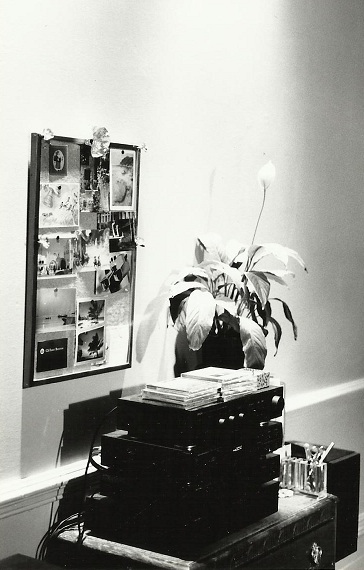
But you were direly warned to use 8 ohm speakers. Because each amplifier was seeing a lowish 4 ohms.
And you need TWO stereo power amplifiers. Did sound good though. The theory is they don't dump signal noise onto the earth rail. Oh, my head!
This forum can hurt my head without drinks, sometimes!
Rotel used to make domestic power amplifiers capable of running bridged mode. Probably still do. I had such a beast.
But you were direly warned to use 8 ohm speakers. Because each amplifier was seeing a lowish 4 ohms.
And you need TWO stereo power amplifiers. Did sound good though. The theory is they don't dump signal noise onto the earth rail. Oh, my head!
I am amazed that Volvo promotes crazy the-Devil-may-care driving.Well, I could buy a car "of the future", since it is a fact that they will go from 12 V to 48 volts ...
Of course, costs are not justified to remove the amplifier and then give it the use that the OP requires ......
Oh, the drinks from last night have hurt me, leave it there, I haven't said anything!
Por que los sistemas electricos de los coches estan cambiando de 12 a 48 voltios - Tecvolucion
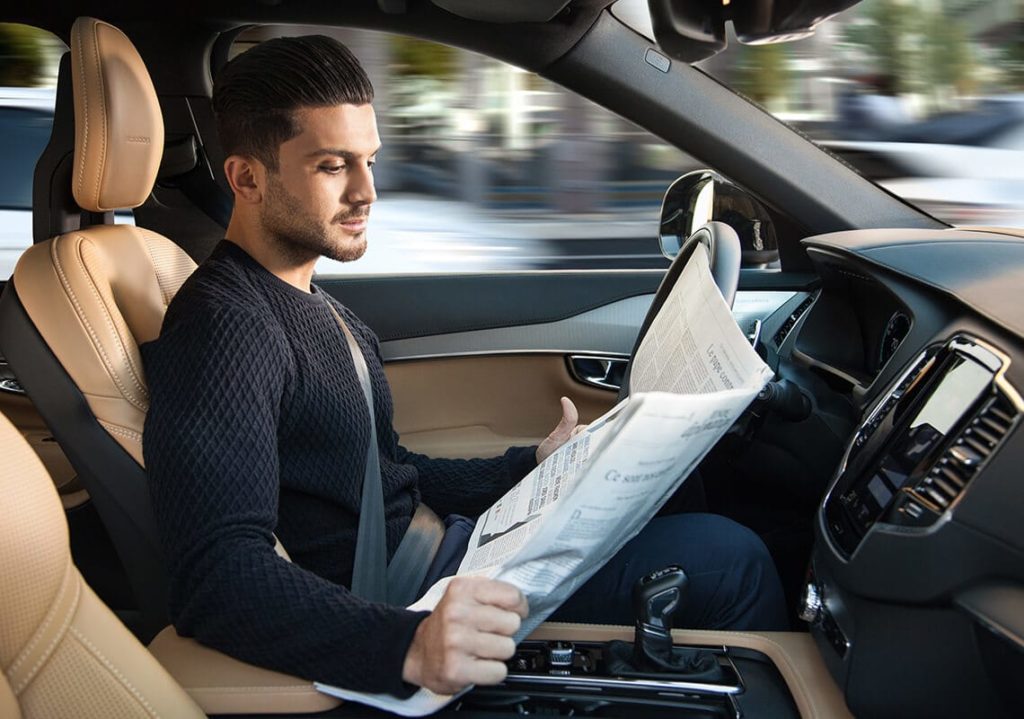
Notice the car is running at high speed (speed blurred scenery through windows) yet the idiotic driver has left the driving wheel and is reading the newspaper (or a map, or whatever)
WTF Volvo?
I would like to make a 3-way speaker with all 3 drivers being 8 ohm individual.
I have not best but decent amp from my car setup. 2x150w rms@2 ohms or 2x75w rms@4 ohms.
Do they have you confused enough yet?
With a three way crossover using 8 ohm drivers, you will have an 8 ohm speaker. The drivers do not all work at the same time, each has it's own frequency range to cover, so they are not actually in parallel.
The specs for amplifiers are a minimum impedance. All but the most brain dead of them will work just fine with higher impedance. Your 2 ohm amp will run 8 ohm speakers just fine. The limit is mostly about current draw. It will almost certainly run cooler and will probably produce a bit less distortion.
So hook it all up and enjoy.
The car is on a low loader which moves along the roadway, allowing the camera crew to film a natural looking car movement.Notice the car is running at high speed (speed blurred scenery through windows) yet the idiotic driver has left the driving wheel and is reading the newspaper.
Attachments
Hi Makonga!Good day, community. I would like to make a 3-way speaker with all 3 drivers being 8 ohm individual.
When the members of this community think of a 3-way speaker, they think of a high frequency driver, a dedicated midrange frequency driver and a bass frequency driver, all powered via a 3-way crossover.
Choosing 8 ohm drivers will result in an 8 ohm 3-way combination - for 4 ohm choose 4 ohm drivers.
You have confused the issue by showing four drivers which don't adhere to the above pattern.
The attached diagram shows the simplest 3-way arrangement possible.
A single capacitor directs the high frequencies to the tweeter, a series capacitor and inductor combination directs the midrange frequencies to the midrange driver and a single inductor directs the low frequencies to the bass driver.
I hope the above information may assist you in designing your 3-way speakers.
Attachments
JMFahey and Galu, is an automatic driving vehicle, as tsmith1315 mentioned
Here is an account of an experience in a Tesla.
Yes, it's real, I'm sober now ...
Paenza en un Tesla (y escuchando la radio de los porteros) - ARGENTINA AUTOBLOG
A paragraph of the article says:
" Now, read this carefully. The car looked for a place to park (se). Yes. He walked slowly down the street where we would have to leave until he found a place. And he parked alone. That easy. He did what you (or I) would do: he stood parallel and then stepped back to the place he had chosen, and in two maneuvers he stopped. I asked more questions and we returned. Actually, both Scott and I could have sat back. At the traffic lights he waited respectfully and in the zebras he waited for the pedestrians to cross. When the vehicles in front of us on the highway slowed down, the Tesla also, keeping a safe distance (in case I had to brake sharply, I suppose). The car also knows the maximum allowed speed, and adapts. If you want to pass a vehicle ahead, all you have to do is turn on the turn signal. That is the indication. When traffic permits, Tesla accelerates and leaves it behind."
Sorry OT
Here is an account of an experience in a Tesla.
Yes, it's real, I'm sober now ...
Paenza en un Tesla (y escuchando la radio de los porteros) - ARGENTINA AUTOBLOG
A paragraph of the article says:
" Now, read this carefully. The car looked for a place to park (se). Yes. He walked slowly down the street where we would have to leave until he found a place. And he parked alone. That easy. He did what you (or I) would do: he stood parallel and then stepped back to the place he had chosen, and in two maneuvers he stopped. I asked more questions and we returned. Actually, both Scott and I could have sat back. At the traffic lights he waited respectfully and in the zebras he waited for the pedestrians to cross. When the vehicles in front of us on the highway slowed down, the Tesla also, keeping a safe distance (in case I had to brake sharply, I suppose). The car also knows the maximum allowed speed, and adapts. If you want to pass a vehicle ahead, all you have to do is turn on the turn signal. That is the indication. When traffic permits, Tesla accelerates and leaves it behind."
Sorry OT
Hi Makonga!
When the members of this community think of a 3-way speaker, they think of a high frequency driver, a dedicated midrange frequency driver and a bass frequency driver, all powered via a 3-way crossover.
Choosing 8 ohm drivers will result in an 8 ohm 3-way combination - for 4 ohm choose 4 ohm drivers.
You have confused the issue by showing four drivers which don't adhere to the above pattern.
The attached diagram shows the simplest 3-way arrangement possible.
A single capacitor directs the high frequencies to the tweeter, a series capacitor and inductor combination directs the midrange frequencies to the midrange driver and a single inductor directs the low frequencies to the bass driver.
I hope the above information may assist you in designing your 3-way speakers.
Actually, if you want to reduce it further, it is not necessary to use the inductor in the bass speaker.
There have been "high pass / mechanical" media filters since long ago
My JBL LE14C is like this, the signal with all the frequency content goes to the speaker cone, then, the undulations filter the treble naturally (cone break? CSD?) To a sector in which the average frequencies reproduce in the smooth sector which is close to the center of the speaker.
I never designed a crossover, although today there are programs to do it. But not everything is as the books say. For example, something very accepted is that the media speaker must be isolated Yes or Yes from the twoofer and tweeter ......
Troels does not do it in the DTQWTII, JBL did not do it in the LE14C, and I attest that both have excellent means, with a lot of impact and naturalness.
I owe them the attachments.
Yep, my bookshelves run the bass/mid direct, relying on an initial 6dB per octave slope down from 5kHz which is inherent in the construction of the driver.Actually, if you want to reduce it further, it is not necessary to use the inductor in the bass speaker.
Crunch GP2150 2 Channel Ground Power Amplifier:
Crunch GP2150 2 Channel Ground Power Amplifier [Crunch GP2150] - PS79.99 : Car Audio 4 Less, Car Audio System
This is a car amplifier, so runs on single rail 12V car battery power.
Problem with car stereo is the lack of volts available, so you tend to use 4 ohm drivers which are louder. You can also use bridged mode for more power with two amplifiers in opposite polarity, but that would get complicated.
Car amplifiers of this type are not limited by the nominal 12 volt supply.
They use DC-DC power supplies to generate dual rail voltages to suit the amplifier output power. Larger amplifiers require more supply current.
This type of amplifier typically has one of each pair of output channels phase reversed, to make bridging easy.
- Status
- This old topic is closed. If you want to reopen this topic, contact a moderator using the "Report Post" button.
- Home
- Loudspeakers
- Multi-Way
- 3-way speaker to 8 ohm crossover to 2 ohm amp?
